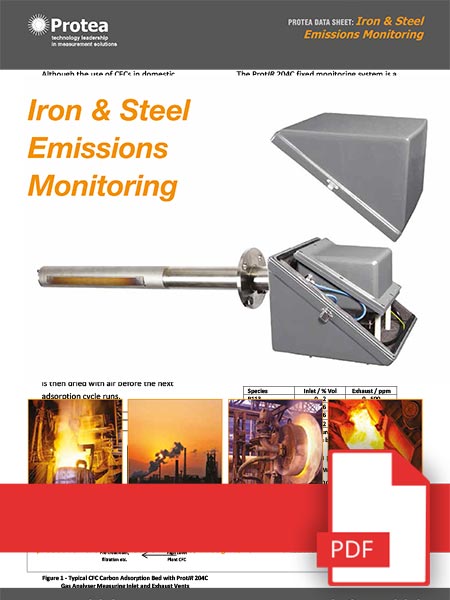Iron, Steel & Aluminium Production
Protea’s range of emissions analysers can be used to monitoring pollutants across the metal production industries. Such as for demanding steel processes like initial sintering of ore, coke production and blast furnace emissions, through to roll-mill reheat furnace emissions.
Iron & Steel Emissions Monitoring
Protea analysers are used throughout the steel process from initial sintering of ore, coke production and blast furnace emissions, through to roll-mill reheat furnace emissions.
Of particular concern in this application are very high particulate loading and extreme temperatures both in the gas flux and ambient.
Gases can often be both in high concentrations and highly corrosive. The combination of reliability, corrosion resistance and flexibility of application enables the multicomponent, in situ analyser to meet the requirements of the end-user and local Environmental Agencies.
The P2000 analyser range is well suited to applications with a high dust load. Patented sintered filter technology is used to pre-clean the sample gas. No maintenance is required during operation and there are no additional consumables, ensuring a simple and well tested solution offering up-time for control of your plant.
PFC Emissions From the Aluminium Industry
The aluminium industry is the major source of perflurocarbon (PFC) emissions to the atmosphere, which are a major contributor to global warming. PFCs have greenhouse gas effects up to 10000 times that of CO2. Emissions have been reduced over the last 20 years, but further reductions are harder to achieve as all the mechanisms for PFC production are not known. In order to better understand the production of PFC on an industrial level, laboratory studies have been carried out using a small scale cell.
A controlled potential electrolysis was combined with gas analysis using Protea gas analysers to study the PFC production. By studying the behaviour of cells before and during the anode effect time and measuring the composition of the off-gases, further knowledge of the PFC production process was gained. This can be used to identify signs that can be used as early warnings for anode effect.
The combination of Quadrupole Mass Spectrometry (QMS) and Fourier Transform Infra-Red (FTIR) spectroscopy was used to provide full-species measurement of the process. The fast response of the MS and the high resolution of the FTIR is a powerful tool to determine the gas composition.
| Detected and Measured Species |
|---|
| CF4 |
| C2F6 |
| CO |
| COS |
| COF2 |
| HF |
| SF6 |
| SiF4 |
| SO2 |

